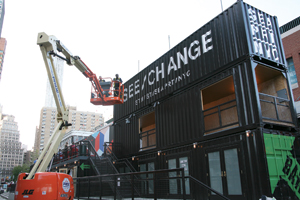Developers Converting Shipping Containers Into Structures for Business, Residential Use

There is nothing glamorous about shipping containers. Their existence generally is one of sheer duty, hauling cargo from one point to another. However, thanks to some entrepreneurial thinking and good old-fashioned ingenuity, shipping containers are getting a second life and being repurposed as the foundation for everything from homes and offices to restaurants and gardens.
While the containers still are bound to serving a need, these second lives can bring a measure of style, design and, perhaps, glamour to cargo holds that have hauled their last shipment.
New York-based SG Blocks, which is developing a wide variety of container applications, estimates that there are 20 million shipping containers in the world. That’s an awfully plentiful resource for those interested in finding one.
And lots of people are interested.
In Detroit, a city rebounding from municipal bankruptcy, a community group last year approached General Motors Co. looking for support in an effort to transform a shipping container into a farmhouse as part of an urban farming initiative.
“I met with The Michigan Urban Farming Initiative former co-founder Darin McLesky a few years ago about their overall urban farming program and efforts,” GM spokesman David Darovitz said. “He presented a quite lengthy document, and in it was the idea of using a container as a farmhouse. I immediately recognized that as an opportunity to help.”
Turning a container into a farmhouse required some of the same kinds of skills that are used to turn hunks of steel into cars, so GM felt that its workforce at its Detroit-Hamtramck assembly plant — which produces the Chevrolet Volt electric car — could handle the job.
“At the plant, we have several talented, skilled trades employees . . . that could accomplish the roughing-in of the container — that is, steel cutting, framing, electrical and plumbing work,” Darovitz said.
Turning a shipping container into a home involves a lot of outside materials, of course, but they by no means have to be conventional — as GM and its employees discovered while working on the project.
“The front windows, for example, were old freezer doors that were repurposed into windows for the container home,” Darovitz said. “We have some old windows on the other side of the container that were donated by MUFI from old homes in Detroit, [and] we donated some materials such as electrical and plumbing, wood for flooring. I did purchase a small sink, a new shower base and some drywall, [but] about 80% of the building will be made of recycled and reused materials.”
The ability to repurpose both the container and its appointments makes for a compelling environmental argument, but the conversion process does present challenges, said Douglas Hecker, co-founder of the Clemson, South Carolina-based design firm fieldoffice and a professor at Clemson University. He is completing work on a project with SG Blocks for the Smoky Park Supper Club restaurant in nearby Asheville, North Carolina.
“The width is really a challenge as a building module,” he said. “If it was 12 feet wide, it would make for a much better building module.”
He also noted that the structures are not always easy to work with.
“The first challenge is just the modular structure itself, given how robust it is and that it’s waterproof and termite-proof,” Hecker said. “As soon as you alter it, you’re altering all that.”
Finding people to make those alterations also can be a difficult, he said. On the project with SG Block, Hecker and his team used engineered, cut-open reinforced block for plumbing and electrical, but finding qualified builders to work with such an arrangement presented a challenge.
“Quite a bit of that happens off-site, but you still need — in the initial moments on-site in the first couple weeks — you need more high-skilled people to deal with attachments to steel and stuff, and in certain markets that’s a bit more challenging to find,” he said. “Most people are used to working with wood and things.”
SG Blocks works from dry-freight containers measuring 8 feet, 6 inches high for 20-foot and 40-foot units, as well as taller 9-foot, 6-inch containers for some of the 40-foot units. Its structures can use facades made from limestone, stucco, shingles, brownstone, brick and aluminum siding. The company says it can build a one-story structure for $30 per square foot, although the cost per square foot rises as the structure adds more stories.
SG Blocks recent projects have included a 480-square-foot showroom for Mini Cooper, which was built in 21 days, and a facility for New York’s South Street Seaport that stands at 3,200 square feet and was completed in less than five weeks.
Despite the variety of potential applications, Hecker noted that container buildings can limit builders in terms of structure height. If a container is 9 feet high, and that’s not enough, you can stack another one on top and go to 18. But you can do only the height that the container or containers come in, he said. He noted that can also simplify life for a designer.
“The predictability leads to a lack of arbitrariness in the design process,” Hecker said. “If the client wants to use containers, it’s probably for a very specific reason, so a lot of emotional and arbitrary questions about design tend to go away. You know what you’re dealing with. They really are like Legos. They like to be stacked and put corner-to-corner and things like that.”
But these limitations do not mean that it’s impossible to make container homes a very high-end proposition. In the Denver neighborhood of LoHi, a company called LoHi Container decided to shoot for the higher end of the market by developing a single, three-story, 2,100-square-foot container home that it placed right in the middle of this well-established neighborhood, within walking distance of the central city. The parcel of property that now features the house literally was a vacant lot one day and a ready-to-occupy house — constructed from nine different containers — the next. Crews quickly laid a foundation for the house on the same day they brought the containers to the site and assembled them with the help of a large crane.
Local real estate agent Sunny Leu-Pierre, who is listing the house, said the response from prospective buyers has been one of astonishment.
“They’re blown away,” Leu-Pierre said. “They think it’s such a neat concept. LoHi is the No. 1 neighborhood in Denver, so it was very calculated as to where they put the property.”
The house, which features a spiral staircase and a variety of high-end finishes, has an asking price of $749,000. Leu-Pierre is getting her share of interested buyers, but she’s also getting a lot of sheer curiosity.
“It’s a completely different concept,” Leu-Pierre said. “The first week, we had so many people who were just asking, ‘Oh, what is this thing?’ I get so many phone calls from people who want to know how it was put together. You’ve got to think about it. They’re shipping containers.”
On the other end of the affordability spectrum, architect Benjamin Garcia Saxe — who designed SG’s South Street project — also created a 1,000-square-foot home in Costa Rica for a mere $40,000 using two 40-foot shipping containers. He was trying to help the couple who would live in the home avoid going into debt.
That said, the affordability of container homes sometimes can be overstated, Hecker said. He noted that people sometimes come to him with unrealistic expectations based on things they’ve read online.
“I think a lot of people see things on the Internet that are not necessarily correct about building a container home for $2,500 or something like that,” Hecker said. “So a lot of people come into it with false expectations. For someone who wants to recycle a container and turn it into a home, they can do it very affordably, but if someone comes to me and says, ‘Can I build a home for $5,000?’ The answer is no.”




